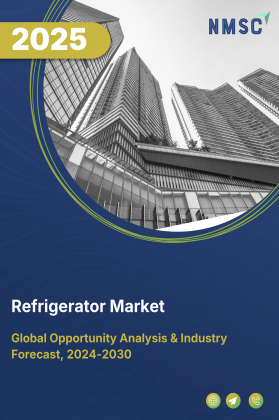
Refrigerator Market by Type (Single Door, Double Door, Side by Side, Top Freezer and Others), By Structure (Freestanding, Built-in / Integrated, Under Counter / Compact Units), By Capacity (Less than 15 Cubic Feet, 16 to 30 Cubic Feet, Above 30 Cubic Feet), By Technology / Feature (Energy Efficient Refrigerators, Frost Free / No Frost and Others), By End User (Residential and commercial) – Global Analysis & Forecast, 2025–2030
Industry Outlook
The global Refrigerator Market size was valued at USD 107.47 billion in 2024, and is expected to be valued at USD 114.21 billion by the end of 2025. The industry is projected to grow, hitting USD 154.77 billion by 2030, with a CAGR of 6.27% between 2025 and 2030.
The refrigerator market is experiencing rapid transformation driven by evolving consumer expectations and the expansion of complementary services such as installation, maintenance, and smart-home integration. Increased adoption of advanced features like energy-efficient technologies, inverter systems, and smart connectivity provides consumers with greater convenience and control, enabling access to a broader range of functionalities including remote monitoring, temperature customization, and automated maintenance alerts. This trend allows manufacturers and service providers to develop bundled solutions and subscription-based maintenance programs, enhancing customer engagement, fostering brand loyalty, and increasing overall revenue potential. By aligning product offerings with the needs of tech-savvy and efficiency-conscious consumers, companies deliver comprehensive, outcome-driven solutions that strengthen their market position.
Simultaneously, a growing emphasis on sustainability and energy savings is shaping product demand and innovation. Awareness of rising energy costs and environmental impact is encouraging consumers to adopt eco-friendly and high-efficiency refrigerators, while innovations such as frost-free technology, smart dispensers, and adaptive cooling systems are redefining user expectations. This cultural shift toward smarter, greener, and more convenient appliances creates opportunities for providers to design targeted solutions, expand product portfolios, and deepen customer relationships. Together, these factors are driving technological innovation, broadening product applications, and reinforcing the growth and competitiveness of the market.
What are the Key Trends in Refrigerator Industry?
How is the Refrigerator Market Adapting to the Demand for Energy Efficiency?
The global refrigerator market growth is increasingly driven by demand for energy-efficient appliances, reflecting a broader push toward sustainability and reduced energy consumption. Regulatory bodies worldwide are playing a key role, with initiatives such as energy efficiency labeling programs helping consumers make informed purchasing decisions. These measures are driving higher adoption of refrigerators that consume less power, while also encouraging manufacturers to innovate in cooling technologies and appliance design. Programs like national cooling action plans in various countries are further promoting energy efficiency across the refrigeration sector, underscoring the importance of environmentally responsible solutions.
For companies operating in this market, aligning product portfolios with global energy efficiency standards is critical. Investing in research and development to exceed regulatory benchmarks deliver operational cost savings to consumers and strengthen brand competitiveness. Incorporating advanced technologies such as inverter compressors, adaptive cooling systems, and smart sensors further enhance energy efficiency, enabling manufacturers to meet the expectations of a growing environmentally conscious consumer base and position themselves as leaders in a sustainability-driven global market.
What Role is Smart Technology Playing in the Evolution of Refrigerators?
Smart refrigerators are rapidly gaining traction across the global market, driven by the widespread adoption of connected home technologies and the increasing emphasis on energy efficiency and convenience by energy and technology organizations. These appliances now offer features such as remote monitoring, automated inventory tracking, temperature optimization, and real-time energy consumption insights, enhancing both functionality and user experience. For manufacturers, investing in IoT connectivity, AI-powered features, and seamless integration with home automation platforms is essential to remain competitive, attract tech-savvy consumers, and meet the growing demand for connected homes. Strategic collaborations with smart home ecosystems further expand reach and adoption, enabling companies to differentiate their products, increase consumer engagement, and strengthen their position in a rapidly evolving, technology-driven global market.
What are the Key Market Drivers, Breakthroughs, and Investment Opportunities that will Shape the Refrigerator Industry in Next Decade?
The global refrigerator market is witnessing strong growth, driven by rising household disposable incomes, urbanization, and increasing consumer demand for advanced and energy-efficient appliances. As households gain greater purchasing power, they are investing in refrigerators with enhanced storage, smart technology integration, and sustainable features. Manufacturers are responding by offering innovative, user-friendly products that align with evolving lifestyles and space constraints, particularly for urban consumers. Bundled solutions such as installation, maintenance, and smart-home integration are enabling providers to optimize operations, enhance customer satisfaction, and cater to both routine and specialized needs, creating new revenue opportunities and strengthening long-term brand loyalty.
At the same time, the market is shaped by challenges and opportunities linked to supply chain dynamics, inflationary pressures, and government incentives for energy-efficient appliances. Rising production costs and component shortages are encouraging manufacturers to optimize sourcing strategies and operational efficiency, while rebate programs and sustainability initiatives are promoting the adoption of eco-friendly refrigerators. This combination of market demand, regulatory support, and innovation is driving manufacturers to design advanced, environmentally conscious products that meet consumer expectations, expand service offerings, and reinforce the competitiveness of the global market.
Growth Drivers:
How is Rising Household Disposable Income Driving Growth in the Market?
A key driver of the global market is the growth in household disposable income, which directly affects consumers’ purchasing power and preferences for durable goods. As disposable incomes rise, households are increasingly able to invest in high-quality refrigerators with advanced features such as enhanced storage, energy efficiency, and smart technology integration. Data from the OECD show that higher disposable incomes are correlated with greater ownership of electrical appliances and higher consumer demand for energy-efficient products. For manufacturers, this trend underscores the importance of developing innovative, user-friendly refrigerators that meet evolving consumer expectations. Aligning products with global energy efficiency standards not only attracts environmentally conscious buyers but also strengthens brand positioning in a competitive market where rising household incomes are fueling demand for upgraded and feature-rich appliances.
How is Urbanization Influencing the Refrigerator Market Demand?
Urbanization is a major driver of the global market, as the rapid growth of city populations increases the demand for household appliances. According to the OECD, nearly half of the world’s population now lives in urban areas, a share expected to rise to 55% by 2050. This expansion of urban households, combined with rising disposable incomes and evolving lifestyles, is fueling greater adoption of refrigerators worldwide. For manufacturers, this trend highlights opportunities to design and offer products tailored to urban living, such as compact, energy-efficient models with smart features that meet the needs of smaller apartments and tech-savvy consumers. Focusing on urban markets and aligning product offerings with the lifestyle and space constraints of city dwellers help companies capture demand and strengthen their position in the global market.
Growth Inhibitors:
How are Supply Chain Disruptions and Inflationary Pressures Affecting the Refrigerator Market Expansion?
Rising supply chain challenges and inflationary pressures are restraining growth in the global market. According to the OECD, global economic growth is expected to remain slow due to ongoing supply bottlenecks, inflation, and tighter monetary conditions. These factors have increased the cost of critical components such as metals, plastics, and electronic parts, directly affecting manufacturing expenses. Consequently, higher production costs are reflected in retail prices, which limit affordability and dampen consumer demand, especially in emerging markets where price sensitivity is high. For refrigerator manufacturers, this environment emphasizes the need to optimize supply chains, explore alternative sourcing strategies, and improve operational efficiency to maintain competitiveness while balancing cost pressures with market demand.
How are Government Incentives for Energy-Efficient Appliances Creating Opportunities in the Refrigerator Market?
Government incentives for energy-efficient appliances are creating significant growth opportunities in the global refrigerator market by encouraging both consumers and manufacturers to adopt sustainable solutions. Programs such as the U.S. Department of Energy's ENERGY STAR initiative and the Inflation Reduction Act's Home Electrification and Appliance Rebate (HEAR) Program provide rebates and tax credits to households that purchase energy-efficient refrigerators, with the HEAR Program offering up to USD 14,000 in combined incentives for eligible households. These incentives lower the upfront cost, making energy-efficient refrigerators more accessible to a wider audience. For manufacturers, such programs provide a strategic opportunity to develop and promote refrigerators that meet or exceed energy efficiency standards, attract environmentally conscious consumers, and enhance brand competitiveness. By aligning product portfolios with government incentives, companies drive higher adoption of energy-efficient
The chart depicting household disposable income by country in 2024 is highly indicative, as higher disposable income strongly correlates with increased spending on premium and lifestyle-oriented appliances, including refrigerators. Countries with higher disposable incomes, such as Germany, the Netherlands, and Canada, represent attractive markets for refrigerator manufacturers, as consumers in these regions are more likely to invest in advanced, feature-rich, and energy-efficient models. Higher income levels enable households to prioritize convenience, sustainability, and technology integration, driving demand for personalized, high-quality, and innovative refrigeration solutions that cater to evolving lifestyles and expectations.
How is the Refrigerator Industry is Segmented in this Report, and What are the Key Insights from Segmentation Analysis?
By Type Insights
How is the Refrigerator Market Shaped by Type?
Based on type, the market is segmented into single door, double door and others.
The double door segment is popular among consumers seeking a balance of storage, functionality, and energy efficiency. Featuring separate compartments for the freezer and fresh food, this design allows better organization and easier access to frequently used items. Favored by families with moderate to large storage needs, double door refrigerators include frost-free operation, temperature controls, and energy-efficient compressors. Their versatility and practicality make this segment a key contributor to the global market.
By Structure Insights
Which Structure is Emerging as the Most Flexible in the Refrigerator Industry?
Based on structure, the market is segmented into freestanding, built in/ integrated and others.
The freestanding segment includes refrigerators that are standalone units, designed to be placed anywhere in the kitchen without requiring built-in cabinetry or special installation. These units offer flexibility in placement, easy mobility, and are available in a wide range of sizes and styles to suit different household needs. Freestanding refrigerators are the most common choice for consumers due to their convenience, accessibility, and adaptability to various kitchen layouts, making them a significant segment in the global market.
By End User Insights
How is the Refrigerator Market Shaped by End User Segmentation?
Based on end user, the market is segmented into residential and commercial.
The Residential segment includes refrigerators designed for home use. These units are built to meet everyday household needs, offering features like energy efficiency, storage flexibility, and ease of use. They are typically smaller and more user-friendly compared to commercial models, making them ideal for families and personal kitchens.
The chart illustrates the distribution of the global refrigerator market share by end user. Residential users account for the largest share, representing 62.7% of the market, reflecting strong household demand for refrigerators with advanced features, energy efficiency, and smart connectivity. Commercial users make up 37.3% of the market, highlighting the significant demand from hotels, restaurants, offices, hospitals, and retail outlets that require reliable and high-capacity refrigeration solutions. This distribution underscores that while household adoption drives the majority of market growth, commercial applications remain a key segment contributing to overall market expansion.
Regional Outlook
The market is geographically studied across North America, Europe, Asia Pacific, Latin America and the Middle East & Africa and each region is further studied across countries.
Refrigerator Market in North America
North America’s refrigerator market is driven by rising consumer demand for smart, connected, and energy-efficient appliances, alongside growing interest in healthy food preservation and meal-prep trends. The U.S. and Canada see increasing adoption of frost-free, multi-door, and inverter refrigerators due to busy urban lifestyles and awareness of food hygiene. Government incentives promoting eco-friendly and energy-efficient appliances further accelerate sales. E-commerce platforms and appliance financing expand access to premium models, while innovations such as smart temperature controls, app-based monitoring, and AI-enabled diagnostics attract tech-savvy households. Urbanization and higher disposable incomes maintain the region as a key growth market.
Refrigerator Market in the United States
The U.S. market is experiencing steady growth, driven by rising per capita disposable income estimated at USD 52,830.11 in 2025, a 2.6% increase over the previous year and increasing consumer preference for smart, connected, and energy-efficient appliances. Demand for frost-free, inverter, and multi-door models is supported by government incentives promoting eco-friendly products, while e-commerce platforms and financing options make premium models more accessible. Urbanization, busy lifestyles, and heightened awareness of food preservation and hygiene are further encouraging adoption, positioning the U.S. as a key revenue contributor in the North American market.
Refrigerator Market in Canada
Canada’s growth is supported by smart appliance adoption, high energy-efficiency awareness, and urban housing expansion. Consumer preference is shifting toward compact and multi-door refrigerators with advanced cooling technologies. Seasonal demand fluctuations, particularly in winter, boost sales of frost-free and high-capacity models. Additionally, government programs promoting energy-efficient appliances and rebates for environmentally friendly products are driving adoption. E-commerce expansion, coupled with increasing disposable income, allows consumers to access premium and connected refrigerators, positioning Canada as a steadily growing market within North America.
Refrigerator Market in Europe
Europe’s refrigerator market is expanding due to high energy-efficiency awareness, urbanized living, and government-led sustainability initiatives. Countries like Germany, France, the UK, and Spain are driving demand for eco-friendly, frost-free, and multi-door refrigerators that comply with stringent EU energy regulations. Consumers increasingly seek smart appliances with IoT integration, app-based temperature control, and advanced food preservation features. Growing urban households, coupled with lifestyle trends favoring fresh and healthy food storage, boost adoption. Additionally, the rise of modern retail formats and e-commerce platforms provides easy access to premium and connected refrigerators. Technological innovation in low-emission refrigerants and AI-assisted cooling systems further supports market growth.
Refrigerator Market in the United Kingdom
The UK market is driven by high adoption of smart and connected appliances, energy-efficient models, and urban lifestyle trends. Consumers prefer frost-free, multi-door, and inverter refrigerators with advanced cooling technologies. E-commerce and appliance financing broaden access to premium models, while government incentives for eco-friendly products encourage sustainable purchases. Compact designs suit smaller urban households, and innovations like app-based temperature monitoring, humidity control, and multi-compartment storage enhance usability. Rising awareness of food preservation, hygiene, and convenience, along with disposable income growth, positions the UK as a key market in Europe.
Refrigerator Market in Germany
Germany’s refrigerator market is growing steadily, driven by energy-efficiency awareness, demand for premium appliances, and adoption of advanced technologies. Consumers increasingly prefer frost-free, multi-door, and smart refrigerators with app connectivity, while manufacturers are innovating with temperature optimization, humidity-controlled compartments, and inverter technology to align with sustainability initiatives. Urbanization and smaller households are boosting demand for compact and modular designs. In November 2024, MAGNOTHERM, Germany launched the ECLIPSE 2D, a commercial refrigerator with a 1,110-liter capacity that cools entirely without refrigerants. This groundbreaking product represents a major step toward sustainable and safe refrigeration in the commercial sector and beyond. Government regulations promoting energy savings and eco-friendly appliances support adoption, while e-commerce and retail expansion enhance accessibility. Germany’s tech-savvy population and strong disposable income p
Refrigerator Market in France
The France refrigerator sector is steadily expanding, driven by urbanization, rising disposable incomes, and growing consumer demand for energy-efficient, smart, and technologically advanced appliances. For example, LG Electronics expanded its presence in France’s growing market with the launch of InstaView refrigerators featuring MoodUP on May 2024, celebrated with a high-profile event on Paris’s Champs-Élysées. The new bottom-freezer model enhances LG’s premium lineup, catering to rising consumer demand for energy-efficient, smart, and customizable appliances. The launch aligns with broader market trends in France, where urbanization, increasing disposable incomes, and preference for multi-door, frost-free, and IoT-enabled refrigerators are driving adoption of innovative and technologically advanced products.
Refrigerator Market in Spain
Spain’s refrigerator market is growing steadily, driven by high urbanization, increasing digital adoption, and rising consumer interest in energy-efficient appliances. Multi-door, frost-free, and smart refrigerators with app-based controls and optimized storage solutions are increasingly preferred. E-commerce platforms and appliance financing enhance accessibility, while government incentives promote eco-friendly purchases. Compact and modular designs cater to urban households, while the expanding restaurant and foodservice sector drives demand for high-capacity and commercial refrigeration solutions. Innovations such as temperature and humidity control improve food preservation, and seasonal demand fluctuations, rising disposable incomes, and sustainability awareness position Spain as a leading Southern European market.
Refrigerator Market in Asia Pacific
The Asia-Pacific refrigerator industry is witnessing rapid growth due to urban population expansion, rising disposable incomes, and evolving lifestyle preferences. Countries like China, India, Japan, South Korea, and Australia are driving demand for high-capacity, energy-efficient, and smart refrigerators that integrate IoT and app-based controls. Urban households increasingly prefer multi-door, inverter, and frost-free models for better food preservation and convenience. Government initiatives promoting energy-efficient and climate-resilient appliances, coupled with growing retail chains and e-commerce penetration, enhance accessibility. Technological innovation, including AI-powered temperature regulation, modular storage, and eco-friendly refrigerants, positions Asia-Pacific as a major growth hub in the global market.
Refrigerator Market in China
The market is supported by the presence of leading domestic players such as Haier Group Corporation, Midea Group, and Hisense International, which focus on innovation, sustainability, and technology integration. Government incentives, retail expansion, and growing e-commerce channels further enhance accessibility, positioning China as the largest and fastest-growing refrigerator market in the Asia-Pacific region. Moreover, rising disposable incomes, increasing urbanization, and growing consumer awareness of energy efficiency and food preservation continue to drive demand across both household and commercial segments.
Refrigerator Market in Japan
Japan’s refrigerator market is experiencing steady growth, underpinned by a Key domestic player such as Panasonic Corporation, Hitachi, Ltd., and Sharp play a significant role, focusing on innovation, durability, and eco-friendly features to meet evolving consumer preferences. Advanced technologies, including inverter compressors, IoT integration, and precise temperature and humidity control, are enhancing convenience and food preservation. Coupled with government incentives and strong retail and e-commerce presence, these companies strengthen Japan’s position as a mature yet steadily growing market.
Refrigerator Market in India
India’s market is expanding, supported not only by rising household demand but also by the rapid growth of the restaurant and foodservice sector. The industry is becoming more structured, competitive, and diverse, spanning small independent outlets, large QSR chains, and cloud kitchens across urban and Tier 2/3 cities. Rising disposable incomes, changing food habits, and a young population eating out more frequently are driving demand for commercial refrigeration solutions. Simultaneously, digital ordering, delivery services, and technology adoption are shaping operational needs, boosting the demand for energy-efficient, high-capacity, and smart refrigerators across the restaurant segment.
Refrigerator Market in South Korea
South Korea’s refrigerator market is growing steadily, driven by consumer preference for smart, multi-door, and energy-efficient appliances with advanced cooling features and IoT integration. Manufacturers are innovating with modular designs, temperature-controlled zones, and frost-free systems to meet urban household demands. Government incentives promoting eco-friendly appliances, along with expanding e-commerce and retail channels, enhance accessibility. High awareness of food preservation, convenience, and hygiene, combined with a tech-savvy urban population, positions South Korea as a leading market in the Asia-Pacific region.
Refrigerator Market in Australia
Australia’s refrigerator market is increasingly driven by e-commerce adoption, with 17.08 million Australians shopping online monthly in 2024, a 45% rise since 2020. Online platforms have made frost-free, inverter, and multi-door refrigerators with smart features like temperature monitoring, humidity control, and inventory management more accessible to consumers. Retail expansion, appliance financing, and growing digital literacy further support online purchases. Manufacturers are innovating with eco-friendly, high-capacity, and compact designs, positioning Australia as a mature, tech-driven market in the Asia-Pacific region.
Refrigerator Market in Latin America
Latin America’s market is expanding due to rapid urban population growth, increasing household electrification, and rising disposable incomes. Brazil, Mexico, and Argentina are driving demand for frost-free, inverter, and multi-door refrigerators that provide energy efficiency and large storage capacity. Seasonal variations, especially during hotter months, boost appliance sales, while government programs promoting energy-efficient appliances and climate-adapted technologies further support adoption. Urbanization, coupled with the proliferation of retail chains and e-commerce platforms, allows broader access to premium models. Manufacturers are innovating with modular designs, temperature-controlled compartments, and eco-friendly cooling systems, positioning Latin America as a growing market.
Refrigerator Market in the Middle East & Africa
The Middle East & Africa market is driven by extreme climatic conditions, increasing urbanization, and government investments in smart housing and infrastructure projects. Consumers in UAE, Saudi Arabia, and South Africa prefer high-capacity, frost-free, and inverter refrigerators suitable for hot and humid environments. Rising disposable incomes and modern lifestyle adoption increase demand for smart, connected appliances. Expansion of modern retail formats, appliance financing options, and e-commerce platforms enhance accessibility. Additionally, eco-friendly and energy-efficient innovations, such as solar-compatible refrigeration in remote areas, are gaining traction, making the region a unique growth opportunity in both urban and rural markets.
The chart, titled "Technology Readiness Index, By Country in 2024" from Next Move Strategy Consulting, displays the Technology Readiness Index (TRI) scores for six Asia-Pacific countries: China (65.3), Japan (63.8), Australia (60.5), South Korea (60.1), Indonesia (56.1), and India (52.6). This index measures a country’s capacity to adopt and integrate ICT, impacting market growth by driving demand for smart appliances in high-scoring nations like China and Japan, where IoT-enabled refrigerators thrive due to robust tech infrastructure.
Competitive Landscape
Who are the Leading Companies in the Refrigerator Industry and How are they Competing?
The global refrigerator market competition is shaped by a mix of established manufacturing giants and agile, innovation-driven specialists. Companies such as Samsung, LG Electronics, Whirlpool Corporation, Panasonic Corporation, and Hitachi dominate the market through extensive product portfolios, global distribution networks, and strong brand recognition. They focus on delivering high-quality, reliable, and energy-efficient refrigerators with advanced features such as smart connectivity, inverter technology, and flexible storage solutions. Their emphasis on durability, performance, and brand trust helps them cater to the growing demand for modern and convenient kitchen appliances, ensuring they remain key players in the evolving refrigerator landscape.
Meanwhile, specialized and technology-focused innovators like Electrolux AB, Godrej Group, Haier Group, Midea Group, Voltas Limited, GE Appliances, Havells, Liebherr, Hisense International, and Sharp focus on niche segments, unique features, and design-led products. These companies emphasize smart home integration, eco-friendly refrigeration, modular designs, and energy efficiency innovations. Their agility in responding to changing consumer preferences and adopting new technologies creates competitive pressure on established players, pushing the market toward more personalized, sustainable, and feature-rich refrigerator solutions.
Market Dominated by Refrigerator Giants and Specialists
The refrigerator market is increasingly shaped by a mix of established manufacturing leaders and specialized innovators. Companies like Samsung, LG Electronics, Whirlpool Corporation, Panasonic Corporation, and Hitachi dominate the market with comprehensive product portfolios offering advanced cooling technologies, smart connectivity, energy efficiency, flexible storage, and modern designs, supported by global distribution networks and strong brand loyalty. Meanwhile, players such as Electrolux AB, Godrej Group, Haier Group Corporation, Midea Group, Voltas Limited, GE Appliances, Havells, Liebherr, Hisense International, and Sharp focus on niche and technology-driven solutions, including modular designs, eco-friendly refrigeration, app-controlled smart units, and luxury or compact models. Together, these companies drive innovation, enhance competitive differentiation, and fuel market growth by meeting evolving consumer demands for energy-efficient, convenient, and feature-rich refrigerators.
Innovation and Adaptability Drive Market Success
In the refrigerator market, innovation and adaptability remain key drivers of growth, shaping competitive dynamics and allowing companies to stand out in a rapidly evolving landscape. Samsung’s introduction of the Bespoke 4-Door Flex Refrigerator with AI Family Hub+ and AI Vision Inside at CES 2024, featuring advanced food recognition and smart home integration, highlights how innovation and adaptability drive market success. By combining cutting-edge technology with user-centric design, Samsung not only enhances the convenience and efficiency of food management but also responds to evolving consumer demands for connected and intelligent home appliances. This demonstrates that staying ahead in the market requires continuous innovation, flexible solutions, and the ability to adapt to changing lifestyle trends, ensuring sustained competitiveness and market leadership.
Market Players to Opt for Expansion Strategies to Expand their Presence
In the refrigerator market, strategic expansions are becoming essential for expanding capabilities and accelerating adoption. For instance, GE Appliances’ announcement of a USD 3 billion investment to increase U.S.-based manufacturing, shifting production of refrigerators from China and Mexico to U.S. plants and creating over 1,000 jobs exemplifies how market players opt for expansion strategies to grow their presence. By investing in local production and strengthening domestic operations, GE Appliances not only enhances supply chain efficiency and responsiveness but also reinforces its brand reputation in key markets. This approach highlights that strategic expansion—through investments in manufacturing, workforce development, and regional operations—is a critical pathway for companies to capture greater market share and solidify their position in the competitive refrigerator industry.
List of Key Refrigerator Companies
-
Samsung
-
LG Electronics Inc.
-
Whirlpool Corporation
-
Panasonic Corporation
-
Hitachi, Ltd.
-
Electrolux AB
-
Godrej Group
-
Haier Group Corporation
-
Midea Group
-
Voltas Limited
-
GE Appliances
-
Havells
-
Liebherr
-
Hisense International
-
Sharp
What are the Latest Key Industry Developments?
In May 2025, Godrej Group introduced AI-powered refrigerators with premium features to drive sales growth in 2025, marking a significant development in the market. This move highlights how companies are leveraging smart technologies and advanced functionalities to meet rising consumer demand for connected, efficient, and convenient home appliances. By integrating AI capabilities and premium features, Godrej not only strengthens its product portfolio but also reinforces its competitive position, reflecting the broader trend in the global market toward innovation-driven growth and technology-led differentiation.
In December 2024, LG Electronics unveiled the second-generation LG SIGNATURE refrigerator lineup at CES 2025, showcasing cutting-edge technology and sophisticated design. This news underscores the dynamic nature of the market, where leading companies continually introduce advanced, feature-rich products to meet evolving consumer expectations. By combining innovation, premium aesthetics, and smart functionalities, LG’s launch highlights how product upgrades and technological advancements drive competition, shape market trends, and influence consumer preferences in the global refrigerator industry.
What are the Key Factors Influencing Investment Analysis & Opportunities in the Market?
Investment in the refrigerator market is increasingly driven by innovation, technology adoption, and market expansion opportunities. Companies introducing smart, energy-efficient, and connected refrigerators are attracting significant investor interest, as these products align with evolving consumer preferences for convenience and sustainability. Funding trends show that both established manufacturers and emerging players are leveraging investments to enhance R&D capabilities, launch advanced product lines, and expand into untapped regional markets. Valuations are influenced by a company’s ability to demonstrate growth potential through technological differentiation, brand strength, and operational efficiency, making innovation a key driver for investment decisions.
Geographically, investment hotspots are emerging in regions with growing urbanization, rising disposable incomes, and increasing adoption of modern appliances. Companies targeting these markets through localized production, partnerships, or acquisitions are well-positioned to capitalize on growth opportunities. Additionally, investments are increasingly focused on eco-friendly and energy-efficient refrigeration technologies, which not only meet regulatory and environmental requirements but also appeal to environmentally conscious consumers, enhancing long-term market potential.
Key Benefits for Stakeholders:
Next Move Strategy Consulting (NMSC) presents a comprehensive analysis of the refrigerator market trends, covering historical trends from 2020 through 2024 and offering detailed forecasts through 2030. Our study examines the market at global, regional, and country levels, providing quantitative projections and insights into key growth drivers, challenges, and investment opportunities across all major market segments.
Report Scope:
|
Parameters |
Details |
|
Market Size in 2025 |
USD 114.21 Billion |
|
Revenue Forecast in 2030 |
USD 154.77 Billion |
|
Growth Rate |
CAGR of 6.27% from 2025 to 2030 |
|
Analysis Period |
2024–2030 |
|
Base Year Considered |
2024 |
|
Forecast Period |
2025–2030 |
|
Market Size Estimation |
Billion (USD) |
|
Growth Factors |
|
|
Countries Covered |
33 |
|
Companies Profiled |
15 |
|
Market Share |
Available for 10 companies |
|
Customization Scope |
Free customization (equivalent up to 80 analyst-working hours) after purchase. Addition or alteration to country, regional & segment scope. |
|
Pricing and Purchase Options |
Avail customized purchase options to meet your exact research needs. |
|
Approach |
In-depth primary and secondary research; proprietary databases; rigorous quality control and validation measures. |
|
Analytical Tools |
Porter's Five Forces, SWOT, value chain, and Harvey ball analysis to assess competitive intensity, stakeholder roles, and relative impact of key factors. |
Key Market Segments
By Type
-
Single Door
-
Double Door
-
Side by Side
-
Top Freezer
-
Bottom Freezer
-
French Door
-
Mini or Compact Refrigerators
-
Smart Refrigerators
-
Mobile or Portable Refrigerators
By Structure
-
Freestanding
-
Built-in / Integrated
-
Under Counter / Compact Units
By Capacity
-
Less than 15 Cubic Feet
-
16 to 30 Cubic Feet
-
Above 30 Cubic Feet
By Technology / Feature
-
Energy Efficient Refrigerators
-
Frost Free / No Frost
-
Direct Cool
-
Inverter Technology
-
Smart Connected Features
-
Ice and Water Dispenser Enabled
By End User
-
Residential
-
Commercial
-
Hotels and Restaurants
-
Hospitals and Healthcare Facilities
-
Offices and Corporate Spaces
-
Retail and Food Service Outlets
Geographical Breakdown
-
North America: U.S., Canada, and Mexico.
-
Europe: U.K., Germany, France, Italy, Spain, Sweden, Denmark, Finland, Netherlands, and rest of Europe.
-
Asia Pacific: China, India, Japan, South Korea, Taiwan, Indonesia, Vietnam, Australia, Philippines, Malaysia and rest of APAC.
-
Middle East & Africa (MEA): Saudi Arabia, UAE, Egypt, Israel, Turkey, Nigeria, South Africa, and rest of MEA.
-
Latin America: Brazil, Argentina, Chile, Colombia, and rest of LATAM.
Conclusion & Recommendations
Our report equips stakeholders, industry participants, investors, policy-makers, and consultants with actionable intelligence to capitalize on the market transformative potential. By combining robust data-driven analysis with strategic frameworks, NMSC’s Refrigerator Market Report serves as an indispensable resource for navigating the evolving landscape.




















 Speak to Our Analyst
Speak to Our Analyst

























